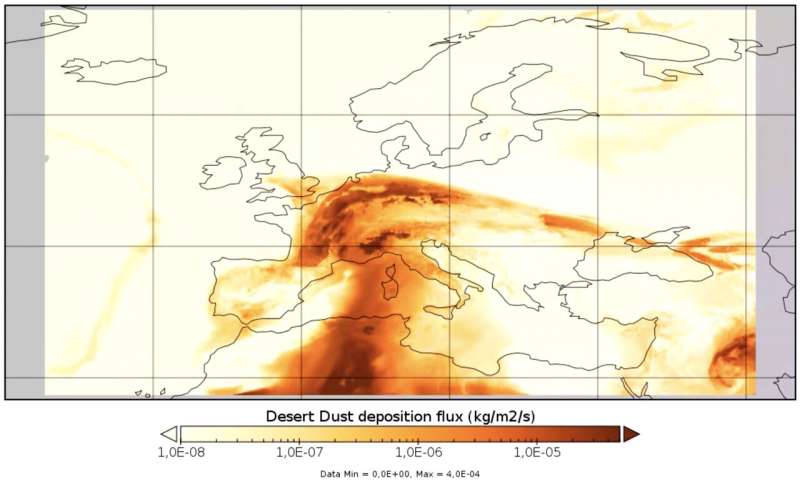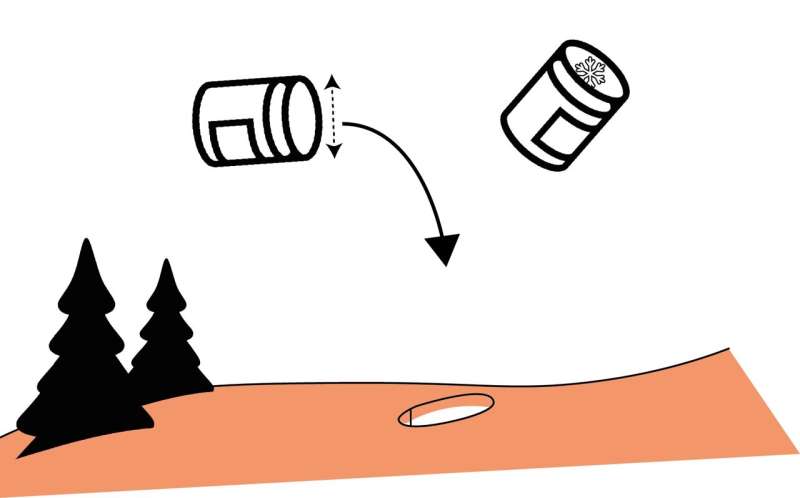Sahara Desert dust found in remote European snow resorts

Saharan dust has made headlines in recent years for traveling across the globe, turning our skies picturesque hues of orange while coating our cities in thin layers of wind-blown dust. This has implications for our infrastructure (for example, reducing solar energy production) and global activities (such as impacting visibility for flights), as well as human health (notably causing respiratory issues) and the natural environment (increasing cloud formation, but reducing temperatures as solar radiation is reflected back out to space).
Europe experienced such an extreme dust deposition event in February 2021. This led to scientists launching a citizen science campaign in which people who were in snow-covered mountain ranges took snow samples, which were analyzed for dust by Dr. Marie Dumont of National Center for Meteorological Research, France, and colleagues.
Volunteers and scientists collected snow samples of 10 x 10 cm2 area through the entire dust layer in the Pyrenees (bordering France and Spain) and European Alps (specifically those spanning France and Switzerland) up to an elevation of 2,500 m above sea level. The collectors then sent the melted contents to laboratories in Toulouse and Grenoble, France, where the samples were filtered and dried to obtain the dust particles.
The results, published in Earth System Science Data, reveal that 152 snow samples were collected from 70 locations over four weeks. Dust volume in the samples ranged from 0.2 to 58.6 g/m2, depending upon location, and particle size decreased with increased distance from the Sahara Desert as heavier and larger particles were deposited first, while smaller and lighter material is carried further by wind.

Dust composition also changed with distance, as particles containing iron were preferentially deposited closer to source where particles were 11% iron by mass in the Pyrenees, but this reduced to 2% in the Swiss Alps. Principle dust deposition also occurred on south-facing slopes in line with dominant wind direction blowing dust from Africa.
Accumulation of dust in ice and snow-covered environments can be damaging as it causes a darkening of the "white" environment, resulting in a negative albedo feedback. This occurs when the darker colors absorb the incoming solar radiation from space and therefore warms the surrounding environment, causing melting of the neighboring snow, which exposes more dark surface and so the loop continues. A good analogy is to think of wearing black clothing in summer which keeps you warmer, compared to white clothing helping to reflect heat and keep you cooler
A dust event in 2018 resulted in reducing the annual snow cover by up to 30 days. Additionally, media attention surrounding the February 2021 dust event suggested that radionuclides (a chemical element that releases radiation as it breaks down) from French nuclear weapon tests had been transported in the dust.
The researchers tested this claim by analyzing the samples for cesium, and found an increase in this element in the Pyrenees. They also detected an increase in short-lived radionucleides of beryllium and lead, which are often associated with fallout from precipitation, hence assumed that these had been deposited in recent snowfall events that incorporated atmospheric dust.
However, plutonium abundances were not significantly different to background levels in the Northern Hemisphere resulting from U.S. and USSR nuclear tests in the 1950s and 1960s.
Dumont and their colleagues suggest that the nuclear signature from this plutonium is likely to be different from that resulting from French nuclear tests conducted in the Sahara in the 1960s due to the use of different fuels and engines, hence predict that the increased cesium and lead signatures measured in the Sahara are also global fallout from these U.S. and USSR tests.
They cite that French nuclear tests had only 0.017% of the power of the U.S. and USSR nuclear projects. This results in a warning of an abundance of caution surrounding media coverage of such dust events in the future and their nuclear links.
There is still more work to be done to ascertain how the predicted increased frequency of these dust events in the future may impact water resources, snow and ice melt and runoff, avalanche hazards and ski resort management.
The importance of this research shows that getting involved in citizen science projects in local communities and when you're traveling can make a real impact in understanding our planet's past, present and future.
More information: Marie Dumont et al, Spatial variability of Saharan dust deposition revealed through a citizen science campaign, Earth System Science Data (2023). DOI: 10.5194/essd-15-3075-2023
© 2023 Science X Network
No comments:
Post a Comment